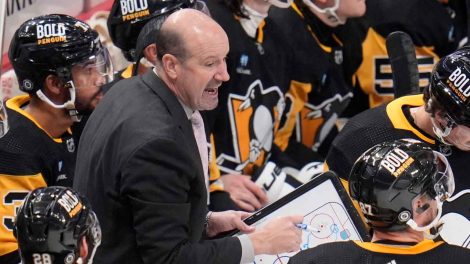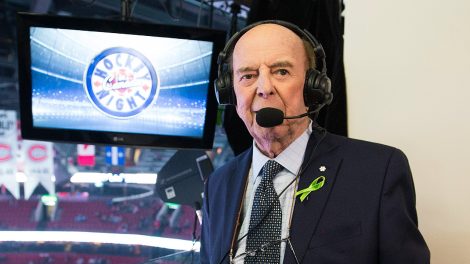Even a casual hockey fan knows that Willie O’Ree became the first black player in the NHL when he played two games for the Boston Bruins in 1958.
How many can name the second black player in the NHL, who arrived 16 years later?
If you said “Mike Marson,” without a Google search, take a bow.
February is Black History Month, and while O’Ree, a longtime hired ambassador for the NHL, is rightly being celebrated and showcased in appearances throughout North America, Marson is largely a forgotten pioneer.
When O’Ree was in Ottawa last week he spent time with Anthony Duclair, a black forward on the Senators. Together, they coached in a charity game honouring the old Coloured Hockey League of the Maritimes, and shared the spotlight during a ceremonial faceoff between the Senators and Anaheim Ducks.
Clearly moved by the presence and gentle manner of O’Ree, Duclair respectfully held the old man’s arm to help him off the ice, revelling in this opportunity to literally walk in O’Ree’s footsteps. Out of curiosity, I asked Duclair this week if he’d ever heard of Mike Marson. He drew a blank, slightly sheepish to learn Marson was just the second black player in the NHL. To his credit, Duclair asked questions about Marson — where did he play and when?
From Toronto, Marson chuckles while talking about a TV commercial for Black History Month without hearing his name or seeing his image.
Living not far from the Scarborough, Ont., home where he grew up, now a painter of acrylic abstracts, a grandfather and a retired TTC bus driver, Marson has come to terms with a lot of things he experienced in a hockey career shortened by hatred.
He doesn’t spend a lot of time dwelling on the death threats he received in the mail, the letters cut out individually from newspaper and magazine headlines by anonymous cowards. Those individual letters spelled out the ‘N’-word and ‘D-I-E.’
As a rookie with the Washington Capitals in 1974, Marson would see mail addressed to him and get a thrill, imagining it was a fan wanting an autograph. Instead it was often a message saying he would “get it” if he appeared in a certain game or, question what he was doing in a “white man’s game.”
Although he was a talented player who grew up in a loving, caring household, Marson suffered personal hardships early in life. At 17, while away playing junior hockey in Sudbury, Marson’s mother, Jackie, died suddenly of a brain aneurysm. A gentle soul, the Bermuda-born Jackie grew to like hockey but couldn’t bear seeing her sons fight while playing — Mike had three brothers and a sister.
“You don’t get over something like that,” Marson says of his mother’s passing.
About four years later Mike’s younger brother, Richard, 20, an aspiring art student at Sheridan College, died of a grand mal seizure. Mike had just had lunch with his siblings the previous day and was on the ice for warmups before a game against the Leafs at Maple Leaf Gardens when he was pulled off and told to call home. His father delivered the tragic news. Mike was devastated.
Today, a young hockey player would be offered counselling for such traumatic, life-altering events. At the time, Marson was left to carry the personal loss far from home, a lonely black man enduring daily abuse no one else in the NHL could appreciate.
“Suck it up and go,” he says. “That’s what you were supposed to do.”
Marson was just 19 when he cracked the Capitals lineup as a junior from the OHA Sudbury Wolves, after cutting his teeth in the Wexford minor hockey association in Scarborough. The Wolves had made Marson their first overall pick; the Capitals took Marson 19th overall, rewarding him with a five-year, $500,000 contract, worried he might jump to the World Hockey Association. Despite scoring 94 points as an 18-year-old junior with the Wolves and 16 goals as an NHL rookie, Marson eventually got distracted from the skills that made him a prospect, fighting to avenge racial slurs and taunts and was gone from pro hockey by age 25. As a rookie, Marson had 28 points and 59 penalty minutes. Three years later, he had eight points and 101 PIM. His career line: 196 NHL games played (151 more than O’Ree), 24 goals, 24 assists, 233 PIM.
It’s easy to see how a little more guidance or change in direction could have helped a player who was a 35-goal scorer as a 17-year-old junior. Easy to see now.
Regrets? Marson has a few. He battled lifestyle issues, including alcohol and an endless fight to keep his weight down, but the overriding element was the “garbage” he faced every day. He has since stopped beating himself up over his abbreviated career.
“For a few years I did that,” he says. “There was even, perhaps, a bitterness. But I could tell you when I turned pro, I was the only person of colour on the planet playing hockey at that level. And I was a teenager.
“I ask anyone who is a man over 50 or 60, if you could go back and fix things when you were young, to a better outcome, would you do it or would you leave it alone? Would you make changes in judgment?”
America in the early 1970s was still embroiled in race issues. One could argue it still is, although athletes of colour are generally treated with respect and dignity. Racial profiling remains a major problem. From Marson’s perspective, it felt as though the Civil War was still on, with old world beliefs entrenched.
“There were places I went to as a National Hockey League player where they weren’t going to allow me to stay in the hotel, where I couldn’t get fed in the dining lounge,” he says.
We don’t feed people like you here, he was told.
“All that stuff you’ve heard about that was evil and wicked? I went through all of that as an 18-year-old just turned 19.”
In today’s NHL, good young players are welcomed as the next big thing — the subject of media profiles and rookie “combines.” In the mid-1970s, the last of hockey’s tough eras, the Broad Street Bullies still roamed and a rookie was supposed to know his “place.” It was bad enough for white rookies. For a black player willing to defend himself, hockey was an endless parade of name-calling and dance partners, including the toughest of the Philadelphia Flyers’ Bullies — Dave Schultz and Don Saleski. Marson also fought Tiger Williams, then a rookie thug for the Toronto Maple Leafs. Though just 5-foot-9 and a strong skater, Marson weighed 200-plus pounds and was fearless. Perhaps to his detriment.
“I had good luck, if you can call it that, with fisticuffs,” Marson says. “So then it became who was going to be the one to set me straight?
“It was like one man against the entire social order of life in North America. And how does he stand up against it? It was endless. You would go to pre-board an airplane, and you can’t pre-board because it’s ‘just for the team.’
How could he be on the team? He was a black guy.
“This was an ongoing, everyday thing where something would go on,” Marson says, growing weary from reflection, his arthritis acting up.
“I’m a born Canadian. My dad was Canadian born. My mother came from Bermuda. We were raised with the concept of, just do your thing. Be creative. Things will work out.”
Except that in this arena at this time, the field had all the advantage. The field being everyone but Marson.
“People weren’t ready. They didn’t know how to handle it. So how was an 18-year-old supposed to do it?
“I tell people,” Marson says, “if you want to get a sense of it, move to someplace in Africa where you’re the only person who looks like you and be at the top of your field and compete. Try that. You will get an insight.
“If I took away those things I experienced as a young player, who knows? But it wasn’t to be. I was the guy to open some doors and then the other guys could come in and take it further.”
Others came. Finally in greater numbers. Tony McKegney. Grant Fuhr. Jarome Iginla. Dustin Byfuglien. Wayne Simmonds. P.K. Subban. Although there should be more, by now close to 100 men of colour have played or do play in the NHL, not sore thumbs anymore, but everyday NHL players. They all owe a debt not just to Willie O’Ree but to Mike Marson, too.
“I would love to be turning pro now,” he says.
His mood brightens as Marson shifts the topic to his current passion, modern art.
After retiring from hockey, Marson became a trainer in the martial arts, but his love of making art, as his late brother did, occupies most of his time approaching his 65th birthday. Even when he played hockey, Marson dabbled in art, studied it.
Marson is inspired by the giants of the canvas. He favours Picasso and van Gogh, but also the Group of Seven, especially Tom Thomson and Lawren Harris. Marson’s art, creating images of faces and masks, perhaps most closely resembles the work of Jean-Michel Basquiat, an American artist of Haitian and Puerto Rican descent who died tragically at age 27.
“I try to come up with a style that kind of mimics what they did, but good luck trying,” Marson laughs.
His style, like his play on the ice, is bold. Several of his works were featured at The Spoke Gallery in Toronto a little over a year ago. Marson was nervous about the show, as he used to be before a big game.
“It was like playing Madison Square Garden or the old Montreal Forum,” he says of the gallery experience.
Marson sees other parallels with sport and art.
“You are still out there, you’re being creative,” he says. “Whether you’re doing a toe drag or putting some kind of different background on a piece of work, you still have to try to reach the people, so they appreciate what it is you’re doing.”
Players and artists are used to being judged, critiqued by their end result.
Finnish artist Martti Nieminen often painted hockey players. He once did a large portrait of former Senators and Calgary Flames enforcer Brian McGrattan; somewhat eerily, McGrattan’s eyes followed you no matter where you stood in the room. That was no coincidence. Nieminen saw McGrattan as a policeman on ice, always watching for a violation of peace, a hurt being put on a teammate.
Marson is similarly focused on the eyes of his subjects.
“When you line up for a faceoff against some of the greats, or you are shoulder to shoulder with someone in the corner, like Jerry ‘King Kong’ Korab, a monster of a man, their eyes turn on,” he says. “They become hunters.”
These days Marson hunts for the instinct to know a painting is finished, that it’s time to move on. Just as he has from an NHL career that brushed paths with Guy Lafleur, Bobby Orr, Marcel Dionne and other luminaries of the 1970s.
[relatedlinks]








